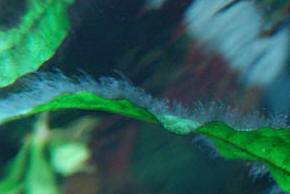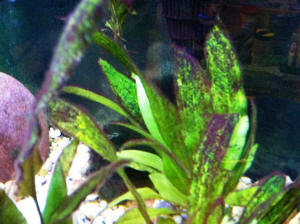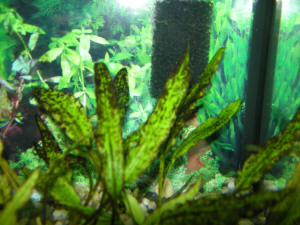|
FAQs on Beard/Brush Blackish (actually a Red)
Freshwater Algae & Their Control
Related Articles: Algae Control in Freshwater
Aquariums by Bob Fenner, Dealing With Algae in
Freshwater Aquaria by Neale Monks, (some) Algae (in moderation) Can Be Your Friend,
ppt presentation, Part 1, Part
2, Part 3, Part 4, Part 5,
Part 6, by Bob
Fenner, Algae
Eaters, Otocinclus, Loricariids, Siamese Algae
Eaters/Crossocheilus,
Related FAQs: Freshwater Algae 1, Algae
Control In Aquarium Gardens 1, & Freshwater Algae
Identification, FW Blue-Green
Algae, FW Algicides,
Algae Eaters, Aquarium Maintenance, Freshwater Aquarium Water Quality,
Treating Tap Water for Aquarium Use,
pH, Alkalinity, Acidity, Freshwater Algae Control, Algae Control, Foods, Feeding, Aquatic Nutrition, Disease,
|

|
Re: BBA Question 8/6/14
Mr. Fenner,
<Hey John>
I wanted to thank you again. I finally got the algae under control.
<Ah, good>
I did have a little hiccup where my light timer decided not to function
and stayed on for a four day stint. Needless to say that gave the BBA
some energy to grow even more, but everything is on track now. I added a
new active carbon filter(Also are there any issues with leaving the
older one in the filter, since essentially once the active carbon is
gone, it's just another filter with beneficial bacteria on it?),
<At some point; yes: the capacity for chemical/physical adsorption gets
used up quite quickly... minutes to hours>
lowered my light on time, trimmed portions of the Amazon Sword that were
overrun with the hair algae, lowered my feeding amount to jump start the
rosy barbs and SAE. I also started using the EasyLife Profito and
EasyCarbo. It seems like everything is going well now. Thanks
for all your input over the years.
V/R
John
<Welcome and thank you for your follow-up, recounting of what worked for
you. Of use to others I assure you. Bob Fenner>
Black slime algae in aquarium sump, planted sys. maint. f'
12/30/12
Hello
<Salve,>
I have wrote before about setting up this 125 gallon Tidepool tank as a
freshwater planted tank. Id like to say it has been success so far
it has been operational with fish and plants for a three months now.
My next and final step is adding a Co2 system.
<Hmm… do read up on these. Join one of the planted aquarium-specific
forums to get help. Automatic systems are fairly easy to use, but the
manual systems can be fiddly.>
My question is my filter pads have been turning black with a slime i
assume is a type of algae and assume its somehow my fault.
<Algae only if exposed to light. Algal blooms of one sort or another are
not uncommon in newly set up freshwater tanks. After a few months things
should settle down though. The addition of fast-growing plants under
bright lighting does a lot to minimise algal problems.>
Fish, plants, and water conditions good. Nothing seems to mind this
black slime in the sumps but me who just spent two hours cleaning it and
i worry it will move into the tank.
<If the sump isn't exposed to light, the black slime is more likely
bacterial, or possibly decaying plant/algal material washed into the
sump. In and of itself detritus in a filter isn't a bad thing, but if it
clogs up the filter media it will reduce water flow and possibly reduce
biological filtration capacity. More frequent filter cleaning can help,
but also look to see what the sources of the detritus might be --
uneaten food, dead vegetation, etc.>
Once again thanks for your advice Jesse.
<Welcome, Neale.>
Black hair algae
12/12/12
Hi
I have an established aquarium for over 18 months, recently I've been
seeing what I think is black hair algae.
<Far from rare.>
My nitrates have reduced following house move to an area with different
water and adding 5 Anubias plants to my already planted tank,
<Anubias are particularly prone to getting black hair algae on the edges
of their leaves. To some degree, pruning helps, but Anubias doesn't grow
very fast, so remove no more than one or maybe two leaves a month from
an plant around 15-20 cm across.>
nitrates are now around 10ppm dropped from 40ppm previously.
<I see.>
From what I've read the low nitrates may be causing the algae, could
this be?
<Abundance of light, and too few fast-growing plants. If you add some
floating plants -- the easiest fast-growing plants to grow -- you
can suppress black hair algae quite well. Physically remove as much as
you can first. Then with fast-growing plants, you should see that black
hair algae grows back slowly.>
Also some sites suggest adding kno3 to boost the macro elements to
prevent algae growth. Would adding more fish increase the nitrate and
maybe help with the algae instead though?
<No; adding fish to solve algae problems almost never works. Do read:
http://www.wetwebmedia.com/ca/volume_6/volume_6_3/fwalgae.html
Some fish will graze black hair algae, but more in the sense of stopping
it growing back after you've tidied up the tank, rather than removing
serious lumps of the stuff.>
Many thanks
Andy
<Cheers, Neale.>
|
Algae, Beard/FW... control
11/2/12
Hello gang, Chris here. I'm having problems getting rid of all this
algae in my tank. It's mainly over the leaves of my live plants. What is
the best way to get rid of this? I have a Plecostomus in my tank but he
doesn't seem to eat this stuff. What are your best suggestions? Thanks
Chris.
<This is red algae, and no, Plecs don't eat the stuff.
Siamese Algae Eaters will prevent the stuff from growing, but their
impact on established tufts is variable, depending somewhat on what else
is available. Note that other algae-eaters, such as Otocinclus, Flying
Foxes, Garra spp., don't eat red algae much if at all. Generally, red
algae (also known as brush, string or hair algae) grows in inverse
proportion to the rate at which your higher plants grow -- if you have
slow plant growth but lots of nutrients in the water, then the red algae
will make up the difference. Tanks with catfish and cichlids are
notorious for this problem because they rarely contain many/any of the
plants that grow quickly enough to make a difference, but do have lots
and lots of nitrate and phosphate in the water. It's not completely
cut-and-dry this, and just because you have 50 mg/l nitrate doesn't mean
you WILL get algae, or that if you keep nitrate below 10 mg/l you WON'T,
but there's an overall pattern that seems to hold. In any case, review
light intensity (i.e., increase it as required) and install lots of
fast-growing plant species (Hygrophila, Vallisneria, or floaters such as
Indian Fern and Amazon Frogbit). The better the plants do, the less the
red algae can compete. Physically remove what you can, disposing of
plants too far infected to be worth keeping (or at least, remove
infected leaves down to the roots if needs be). With plants growing fast
(by which I mean you're cropping back weekly) you'll notice red algae
simply doesn't appear. Hope this makes sense. Cheers, Neale.>
|
 |
|
Algae question FW
3/23/11
Hello Crew,
<Elisabeth>
Here is my situation. I expect that the answer is painfully
simple, but I am new at this.
The TANK: I have a four month old 10 gallon tank with good water
quality (ammonia, nitrites, nitrates are all at 0 PPM).
<0.0 NO3?... a clue that something... plants, algae is taking
all this up... that it may be the rate-limiter of growth
here>
PH is 7.8. Temperature is 78 Fahrenheit. I have one African dwarf
frog, 3 platies, and 2 balloon mollies. (Note that balloon
mollies are smaller so are apparently ok for a 10 gallon tank). I
do water changes twice a week with a gravel vacuum and keep the
tank clean. I think my lighting is full spectrum fluorescent. I
stupidly threw the box away when I first bought the aquarium kit.
I keep the light on about 12 hours per day.
The PROBLEM: I also have a number of plants in the tank. I
don't know exactly what they are.
<Some species of common Cryptocoryne... look in your search
tools, images of such>
Again, I bought them when I first got the aquarium and didn't
write down the information. The plants have seemed fine, but over
the four months, algae has built up on the leaves. I do get algae
on the glass of the tank and remove it with a razor blade every
few weeks, but it seems that the algae on the plants has
seriously built up because there are now dark brown spots all
over.
<I see this, these... may be a type of blue green, or red
algae, so-called "bearded algae". Not easily
controlled>
I pulled out the big rocks in the tank and they were covered too.
I cleaned them off with an old toothbrush but I can't do that
with the plants. The algae on the leaves is so severe that I
think the plants will die. They definitely look terrible.
I read the stuff about algae on this site, but I don't know
what kind of algae this is, so I don't know what to do about
the problem. Is it diatoms?
<Mmm, no>
Is it something else? What can I try to reduce the problem?
<Do see WWM, the Net (through your search tool/s) re
"bearded algae". There are some "algae
eaters" of use here, as well as restricted light (your
Crypts are "low" demand species), other means of
limiting nutrient/s for growth>
I have reduced the light to 10 hours a day, but I would like to
try any other strategies as well in the hope that the plants
don't die.
I have attached photos. Can anyone identify this and suggest ways
to reduce the problem? Thanks so much!!
Elisabeth in Toronto
PS. For Bob who kindly advised me on African dwarf frogs and
whether or not they hunt: The frog is fine. I have learned how to
feed him pellets and frozen foods. But I can report that he did
actually hunt the 6 little Neons down and eat them. I actually
saw him lunge out from behind the tank heater where he was hiding
and narrowly miss the last neon. It was gone later in the day so
he clearly got it eventually. I have since seen him do the same
with the platies, but they are too large and he seems to have
given up of
late. He just waits for the room service instead.
<Thank you for this. Bob Fenner>
|
|

|
|
Re: Algae question 3/23/11
Bob,
<Lis in T>
I am sorry to pester. What is a rate-limiter? If you can just
give me a searchable synonym, I can go with that.
<Ah, sorry re... a nod to "law of the minimum"...
That aspect, step that determines the speed or extent of
re/actions. In your case, due to the absence of nitrate, it (NO3)
is likely the rate determinant... Your plants and the pest algae
are "stopped" from further growth by the lack of this
essential nutrient (and likely others are close)>
Thanks again!
Elisabeth in Toronto
<Cheers, BobF>
|
Trying to Stop the Spread of Black Brush Algae -
3/22/11
Hi!
I have been an avid aquarist for several years now, and never had to
deal with Black Brush Algae. Then one day, I brought an Anubias Nana
Petite home and put it in my 10 gallon planted tank. (Yeah I know, I
should have treated it first) A week later, I saw Black Brush Algae
(BBB) starting to grow on the Anubias. I didn't give it a second
thought because I keep the CO2 injection at a constant 30ppm.
Eventually, I transferred some of the plants from the 10 gallon tank
into my other tanks. Lo and behold, BBB eventually started growing in
my other tanks too! Not a whole lot, just enough to be an nuisance.
I want to start a new planted tank, but I do NOT want BBB in this new
and pristine tank. Thus I am starting off with all new equipment,
substrate, and plants (e.g. none of the plants from my current tanks
will ever set foot in this new tank).
However, I would like to take the bioball media from the 10 gallon
planted tank to 'seed' the good bacteria in the new planted
tank. If I do this, will I risk introducing BBB into the new tank?
If so, then perhaps I can start seeding good bacteria using the
fishless cycling method (e.g. straight ammonia). Thoughts? Thank you
for your time. Sincerely,
Gene
<Hello Gene. The short answer is that the red algae group, which
includes what aquarists call black brush algae, beard algae, and hair
algae, favours bright light. It tends to grow in tanks with good
lighting but few fast-growing higher plants. Anubias and Java ferns are
commonly pestered by this type of algae because they grow slowly. They
make good substrates for red algae to grow upon. But the triggering
factor is very definitely conditions that include bright light and
excess nutrients, quite possibly including elevated CO2 levels. Until
you have fast-growing plants firmly established, the red algae will
thrive. Do remember Anubias and Java fern *do not* do well in open,
bright-light areas. They are much happier (and algae free) in partial
shade. Floating Indian Fern makes a great short-term fix here, if you
still want to work on establishing other plants in the tank. Otherwise
things like Hygrophila, Rotala, Vallisneria etc will do the trick
admirably. In tanks where you're removing handfuls of overgrown
plant leaves per week, red algae is generally absent. For what it's
worth, trying to keep red algae "out" of your tank is a
laudable idea, but I doubt it will work in practise because the algae
spores can get in lots of other ways, too. Cheers, Neale.>
|
|

